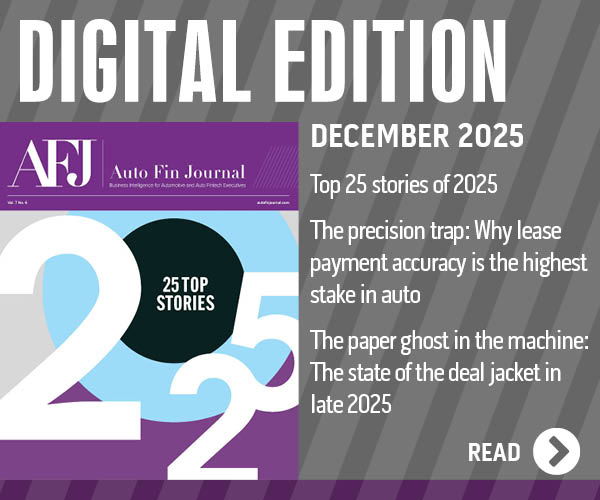Bain and S&P reports highlight growing fintech usage & investment

By subscribing, you agree to receive communications from Auto Remarketing and our partners in accordance with our Privacy Policy. We may share your information with select partners and sponsors who may contact you about their products and services. You may unsubscribe at any time.
LONDON and NEW YORK –
Separate reports from Bain & Co. and S&P Global Market Intelligence detailed how much the COVID-19 pandemic propelled the adoption of digital tools in banking and financing, cultivating a fertile field for more advancements and investments this year and beyond.
Beginning with the consumer-facing perspective, Bain pointed out that customers have turned to digital channels for all kinds of transactions, including the financing and purchasing of vehicles as well as other banking products.
Experts said that as bank branch visits have dropped, change has led to an increase in the hidden defection of consumers, who are now increasingly buying products from banks and providers other than their primary bank.
Now, depending on the country surveyed, between 25% and 51% of all banking product purchases are going to banks that aren’t the surveyed customers’ primary bank. These are among the findings included in Bain’s latest report, As Digital Banking Takes Off, Hidden Defection of Consumers is Rampant.
Over the past few years, Bain said banks have focused on improving their digital services due to increased consumer demand. Improvements to banks’ mobile apps and websites have paid unexpected dividends for customers during the COVID-19 pandemic, according to the report.
While deposits and core current (checking) accounts generally remain at customers’ primary banks, Bain discovered are losing customers on high-margin products such as loans, credit cards and investments.
Subscribe to Auto Remarketing to stay informed and stay ahead.
By subscribing, you agree to receive communications from Auto Remarketing and our partners in accordance with our Privacy Policy. We may share your information with select partners and sponsors who may contact you about their products and services. You may unsubscribe at any time.
“We surveyed more than 56,000 consumers in 11 countries and found that while respondents most frequently cited affordability of a competing offer as their reason for purchasing products from another bank, they also cited better digital tools, a simpler purchasing process and convenience as key reasons,” said Katrina Cuthell, a partner with Bain & Company in Sydney and a co-author of the report.
“These numbers were higher among younger customers, who put an even greater emphasis on digital tools, convenience, branding and security,” Cuthell continued in a news release
If current trends hold, Bain projected that hidden defection will likely intensify in many countries due to the spread of regulations, which will make consumer data portable and thus encourage competition.
The U.K. — which has one of the most competitive banking markets in the world — has the highest defection rate of the 11 countries surveyed. As consumer-friendly, “open-banking” types of regulation take hold in more countries, competition in those markets could intensify. as well, according to Bain’s findings.
“We saw that while some respondents actively search for product options, others respond to ads, with 29 percent of those who defected receiving a direct offer from a competing bank. Of the latter group, 78% said they would be willing to buy from their primary bank if it made a compelling or equivalent offer,” said Gerard du Toit, a Boston-based partner with Bain & Company and the leader of the firm’s global customer experience practice.
“In order to halt the current defection of customers, banks will need to remove the friction that exists in their marketing so consumers won’t feel compelled to shop around, and excel in the basics of opening accounts, so prospective buyers don’t drop off,” du Toit went on to say.
Fintech investment ripe for growth
Now let’s look at the investment angle.
Last year’s favorable market conditions for companies in the U.S. fintech sector are likely to continue throughout 2021, according to S&P Global Market Intelligence’s annual Fintech Market Report.
The new report indicated that the fintech sector not only weathered the storm of the COVID-19 pandemic in 2020, but many subsectors benefited from it, due to the increased use of digital channels by consumers.
Published by S&P Global Market Intelligence’s Financial Institutions Group (FIG) Research team, this report put a spotlight on the current state of digital distribution and fintech.
The report found that changes in consumer behavior driven by the COVID-19 pandemic led to favorable conditions for the fintech sector. These conditions included surges in demand for digital insurance brokers, mobile banking and more.
Coupled with an ample supply of venture capital and the potential for more IPOs and mergers, analysts said the positive trajectory for the sector is expected to remain.
“By now, the fintech sector is probably on everyone’s radar, but the extent to which customers continue to use digital channels after the pandemic passes remains to be seen,” said Thomas Mason, senior research analyst for FIG at S&P Global Market Intelligence.
“At the very least, the pandemic has put a spotlight on both the strengths and weaknesses of digital distribution, offering a stress test of the scalability and fault tolerance of these systems,” Mason continued. “We expect increased digital adoption and the one-stop-shop model to be key themes in 2021, as well as robust IPO and M&A activity in the space.”
Other key highlights from the report included:
— Digital investing: Analysts determined the economic impact of COVID-19 provided a clear windfall to online brokers as U.S. retail investors that already had accounts traded much more heavily, and first-time investors jumped into the action. Charles Schwab, E*TRADE and TD Ameritrade together boosted new accounts in 2020 by 316% in the first quarter and 197% in the second quarter.
— Digital lending: S&P Global Market Intelligence noted the pandemic has been the most significant shock to the non-bank digital lending industry in the past 10 years. Origination volume in the first three quarters of 2020 declined 36% year-over-year across a core group of companies focused on personal lending, small and medium-sized enterprises lending, and student lending.
— Insurtech: Analysts pointed out the insurtech space has been largely unfazed by the pandemic, with many startups still able to grow rapidly, secure venture capital and go public. The creation of insurtech companies that both sell and underwrite policies (also known as full stack) accelerated in 2020, with five property and casualty companies either forming a carrier or announcing the acquisition of one, up from three in 2019 and one in 2018.
—Mobile banking: The latest research found that customers have increasingly turned to their mobile bank apps for basic banking services since the outbreak of COVID-19, forcing institutions to rapidly adjust digital strategies to fill gaps in their offerings. S&P Global Market Intelligence’s 2020 U.S. mobile banking survey found that nearly 58% of respondents indicated that they visited branches less frequently after the COVID-19 outbreak began in the U.S. Overall, 44% of respondents to the survey indicated that they leaned on their mobile banking apps more frequently as a result of the pandemic.
— Mobile payments: The report also mentioned the COVID-19 pandemic has boosted mobile payment adoption in the U.S. and led to record growth among multiple nonbank payment providers. Square’s Cash App saw funds stored in-app grow from $945 million to $1.3 billion in the month of April. PayPal saw net new active accounts nearly double from 3.9 million to 7.4 million in the same month. Both businesses experienced significant growth in users and transaction activity in the months following the initiation of the pandemic.


